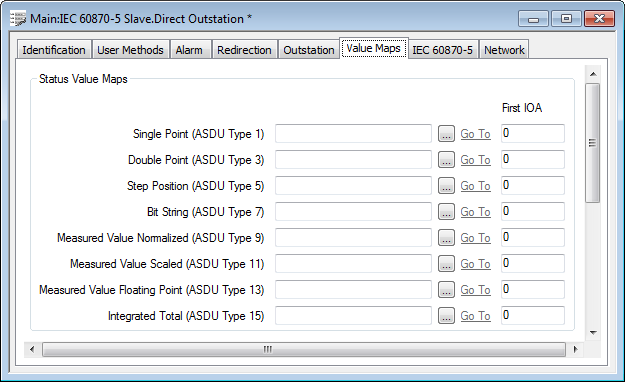Use the fields within the Status Value Maps section of the Value Maps tab to specify the Filtered Value Maps that store the input data for this slave outstation. The Filtered Value Maps that store a slave outstation’s data have to exist on your system before you can use the fields below to map to such data. (For more information, see Specify the Filtered Value Maps that Store the Source Data, and see Configuring Value Maps in the ClearSCADA Guide to Core Configuration.)

- Single Point (ASDU Type 1)—Specify the Filtered Value Map that is used to store single-bit input values. Use the browse button to display a Reference browse window and select the required Filtered BIT Value Map from the window.
- Double Point (ASDU Type 3)—Specify the Filtered Value Map that is used to store the 2-bit input values that represent, for example, the present state of a switch or valve. Use the browse button to display a Reference browse window and select the required Filtered BYTE Value Map from the window.
- Step Position (ASDU Type 5)—Specify the Filtered Value Map that is used to store the 2-bit input values that represent the present step position on a transformer. Use the browse button to display a Reference browse window and select the required Filtered DINT Value Map from the window.
- Bit String (ASDU Type 7)—Specify the Filtered Value Map that is used to store 32-bit string input values. Use the browse button to display a Reference browse window and select the required Filtered UDINT Value Map from the window.
- Measured Value Normalized (ASDU Type 9)—Specify the Filtered Value Map that is used to store ‘normalized’ analog input values (input values that are restricted to the range -1 to +1). Use the browse button to display a Reference browse window and select the required Filtered REAL Value Map from the window.
- Measured Value Scaled (ASDU Type 11)—Specify the Filtered Value Map that is used to store scaled analog input values (input values that are in the range -32678 to +32767). Use the browse button to display a Reference browse window and select the required Filtered DINT Value Map from the window.
- Measured Value Floating Point (ASDU Type 13)—Specify the Filtered Value Map that is used to store IEEE single-precision (32-bit) floating point input values. Use the browse button to display a Reference browse window and select the required Filtered REAL Value Map from the window.
- Integrated Total (ASDU Type 15)—Specify the Filtered Value Map that is used to store counter values. Use the browse button to display a Reference browse window and select the required Filtered DINT Value Map from the window.
Leave the fields blank for any Status Value Map types that are not used by this slave outstation.
For each Filtered Value Map that you specify, use the corresponding First IOA field to specify the address of the first input on that Value Map:
- First IOA—Each input on a slave outstation has an Information Object Address (IOA). This address is used to uniquely identify each item on the outstation and is transmitted in each ASDU that includes information about that particular input.
- Use the First IOA field adjacent to a Filtered Value Map field to specify the IOA address of the first input on that particular Value Map.
- For outstations that communicate using the IEC 60870-5-101 protocol, the valid range for this address varies, depending on the size that is specified for this address on the IEC 60870-5 tab of the Outstation Form (see Configure the IEC 60870-5-101 Parameters). (For Slave Logical outstations, the address is specified on the parent outstation’s Form.)
- If the Information Address Size is 1 Octet, the valid Information Object Address range is 1 to 255 inclusive.
- If the Information Address Size is 2 Octets, the valid Information Object Address range is 1 to 65535 inclusive.
- If the Information Address Size is 3 Octets, the valid Information Object Address range is 1 to 16777215 inclusive.
- An outstation that communicates using the IEC 60870-5-104 protocol has an Information Address Size of 3 Octets and therefore has a valid address range of 1 to 16777215 inclusive.
- In each case, Address 0 on the Filtered Value Map represents the IOA that you specify in the First IOA field for that Value Map; Address 1 represents the next consecutive IOA, and so on.